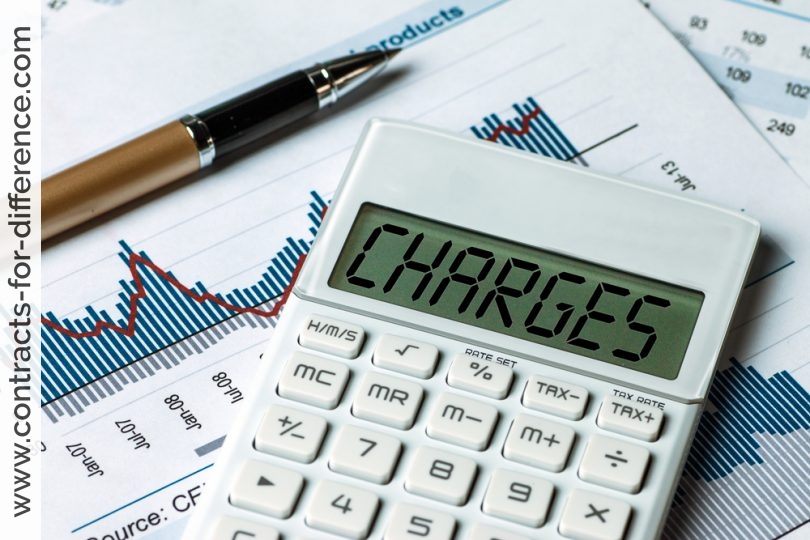You must pay the CFD broker fees and charges to trade CFDs. The charges vary from provider to provider but in practice you will normally be charged each time you open or close a trade.
One of the reasons that trading with Contracts for Difference (CFDs) is so efficient is that you have a large amount of leverage of your money, and in effect you are borrowing from your CFD provider to the value of the underlying financial security. Since you are technically ‘borrowing money’ from your CFD provider, you will be charged what is called a ‘financing charge’ – this works in a similar way to the interest you pay to the bank when you buy a property. In fact, when CFD providers work out the finance charges your initial margin does not even figure in this amount, and you are charged interest based on the whole value of your CFD holding.
It might be a false economy to look for the CFD broker with the cheapest deals if, in a moment of crisis, you just can’t trade. And don’t think that this won’t happen; a number of broker platforms shut down during the most volatile days of the financial meltdown back in October 2008! So while brokerage clearly needs to be competitive, price should not be the only thing to look for when choosing an online CFD broker.
These financing charges have an interest rate which is pegged to a major published rate, such as the LIBOR (London Interbank Offered Rate). Usually you will charged 2% to 3% more than this rate, which is charged for as long as you’re holding an open CFD position. Charges are calculated on a daily basis, which includes the days of any weekend that you hold a CFD position. Note that if you do not hold a position overnight, you will not be charged any interest. You should check with your broker what time the charges are applied.
It depends what style of trading you plan to execute whether the interest rate will be an important cost to your trading. Obviously, with day trading it will not figure at all. If you only hold positions for a few days, then it may not be a large part of your expenses. But if you plan on holding positions for weeks or months, then you will want to consider the size of the addition to the published rate that the CFD provider offers.
If you trade both sides of the market, and are happy to take on short positions (which is very simple to do with CFDs), then you will be paid interest for any position held overnight. Again, the rate is based on a published rate, and this time will be a couple of points less, but it is still nice to be paid while you hold the position.
Remember that when you short a CFD, the CFD provider pays you interest, so the higher the interest the better. When you sell a CFD the lower the interest cost the better for you.
The Product Disclosure statement and the terms and conditions of the client agreement should clearly lay out all fees and any extra charges. It should also clearly set out how interest will be charged on any leveraged trade. While it may not indicate a particular amount, it should provide you a method for calculating the financing fee and explain how and when interest is charged.
What are the charges?
Like dealing with stock brokers to trade physical shares, you will also incur expenses when you trade CFDs. These may include commission (broker fee), margin requiremenets and financing charges. Other direct costs of trading CFDs, and ones which you will want to check with the provider you are considering using, include any data feed or charting subscriptions, and transaction commissions. Most CFD providers will charge a monthly account fee for live market data; this payment is a charge by the exchange and CFD providers simply pass it onto you – this may depend what markets you are involved with. It’s possible that you can get such fees waived or get access to advanced charting tools free of additional cost, particularly if you are an active trader and make a certain number of trades per month. But remember, you are still paying for those trades.
Generally CFD providers will charge you fees for the following -:
- Holding a Position Overnight (financing)
- Exchange Data
- Transaction Fees (commission)
- Trading Platform
- Negative Account Balances
In a similar way to shares dealing, you pay brokerage (or commission) to the CFD provider each time you buy and sell a CFD. The commission will be charged for each transaction, that is both entering and exiting a position, and may be at a level of 0.1% or 0.2% of the underlying cost. In practice, commission varies from one broker to another and you should consult your CFD provider if they offer other commission rates if you’re a frequent trader.
Finally, you should note that there is a hidden cost to trading CFDs built in to the mechanism. You might be quoted on the S&P 500 index, for example, 935.30/935.80. The difference between these numbers is the difference between the prices you can buy and sell at, and represents another cost. It’s not usually as large as the spread for spread betting, but again can vary between providers and keeping it to a reasonable level should be part of your considerations.
Online CFD providers main pitch is the ease with which investors can trade and the provision of tools required to make an informed decision – and all that coupled with competitive pricing. Whatever you do make sure you understand what fees you are paying for the service you are receiving and make sure you understand how you will be charged. It is good practice to keep records of what you pay in dealing fees as these form part of your expenses. Also, should you have any complaints about fees or any other charges that you aren’t able to resolve with the CFD broker, you could always contact the provider’s external dispute resolution scheme.







